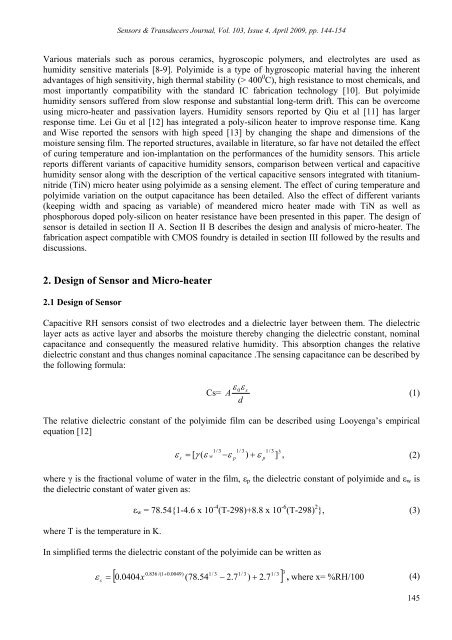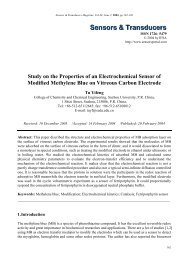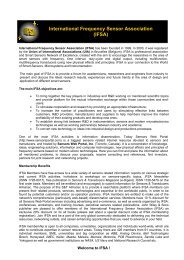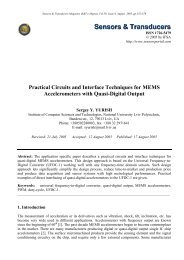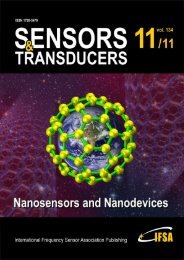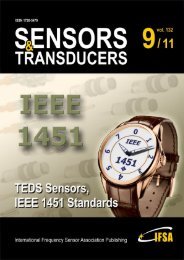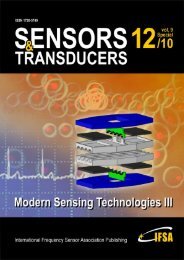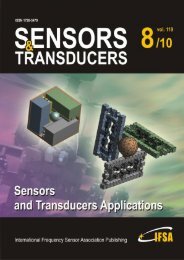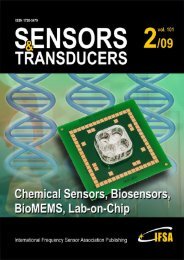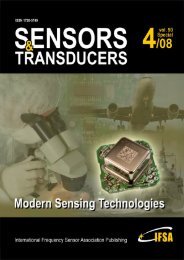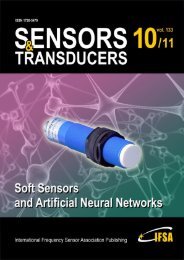Effect of Polyimide Variation and its Curing Temperature on CMOS ...
Effect of Polyimide Variation and its Curing Temperature on CMOS ...
Effect of Polyimide Variation and its Curing Temperature on CMOS ...
Create successful ePaper yourself
Turn your PDF publications into a flip-book with our unique Google optimized e-Paper software.
Sensors & Transducers Journal, Vol. 103, Issue 4, April 2009, pp. 144-154Various materials such as porous ceramics, hygroscopic polymers, <str<strong>on</strong>g>and</str<strong>on</strong>g> electrolytes are used ashumidity sensitive materials [8-9]. <str<strong>on</strong>g>Polyimide</str<strong>on</strong>g> is a type <str<strong>on</strong>g>of</str<strong>on</strong>g> hygroscopic material having the inherentadvantages <str<strong>on</strong>g>of</str<strong>on</strong>g> high sensitivity, high thermal stability (> 400 0 C), high resistance to most chemicals, <str<strong>on</strong>g>and</str<strong>on</strong>g>most importantly compatibility with the st<str<strong>on</strong>g>and</str<strong>on</strong>g>ard IC fabricati<strong>on</strong> technology [10]. But polyimidehumidity sensors suffered from slow resp<strong>on</strong>se <str<strong>on</strong>g>and</str<strong>on</strong>g> substantial l<strong>on</strong>g-term drift. This can be overcomeusing micro-heater <str<strong>on</strong>g>and</str<strong>on</strong>g> passivati<strong>on</strong> layers. Humidity sensors reported by Qiu et al [11] has largerresp<strong>on</strong>se time. Lei Gu et al [12] has integrated a poly-silic<strong>on</strong> heater to improve resp<strong>on</strong>se time. Kang<str<strong>on</strong>g>and</str<strong>on</strong>g> Wise reported the sensors with high speed [13] by changing the shape <str<strong>on</strong>g>and</str<strong>on</strong>g> dimensi<strong>on</strong>s <str<strong>on</strong>g>of</str<strong>on</strong>g> themoisture sensing film. The reported structures, available in literature, so far have not detailed the effect<str<strong>on</strong>g>of</str<strong>on</strong>g> curing temperature <str<strong>on</strong>g>and</str<strong>on</strong>g> i<strong>on</strong>-implantati<strong>on</strong> <strong>on</strong> the performances <str<strong>on</strong>g>of</str<strong>on</strong>g> the humidity sensors. This articlereports different variants <str<strong>on</strong>g>of</str<strong>on</strong>g> capacitive humidity sensors, comparis<strong>on</strong> between vertical <str<strong>on</strong>g>and</str<strong>on</strong>g> capacitivehumidity sensor al<strong>on</strong>g with the descripti<strong>on</strong> <str<strong>on</strong>g>of</str<strong>on</strong>g> the vertical capacitive sensors integrated with titaniumnitride(TiN) micro heater using polyimide as a sensing element. The effect <str<strong>on</strong>g>of</str<strong>on</strong>g> curing temperature <str<strong>on</strong>g>and</str<strong>on</strong>g>polyimide variati<strong>on</strong> <strong>on</strong> the output capacitance has been detailed. Also the effect <str<strong>on</strong>g>of</str<strong>on</strong>g> different variants(keeping width <str<strong>on</strong>g>and</str<strong>on</strong>g> spacing as variable) <str<strong>on</strong>g>of</str<strong>on</strong>g> me<str<strong>on</strong>g>and</str<strong>on</strong>g>ered micro heater made with TiN as well asphosphorous doped poly-silic<strong>on</strong> <strong>on</strong> heater resistance have been presented in this paper. The design <str<strong>on</strong>g>of</str<strong>on</strong>g>sensor is detailed in secti<strong>on</strong> II A. Secti<strong>on</strong> II B describes the design <str<strong>on</strong>g>and</str<strong>on</strong>g> analysis <str<strong>on</strong>g>of</str<strong>on</strong>g> micro-heater. Thefabricati<strong>on</strong> aspect compatible with <strong>CMOS</strong> foundry is detailed in secti<strong>on</strong> III followed by the results <str<strong>on</strong>g>and</str<strong>on</strong>g>discussi<strong>on</strong>s.2. Design <str<strong>on</strong>g>of</str<strong>on</strong>g> Sensor <str<strong>on</strong>g>and</str<strong>on</strong>g> Micro-heater2.1 Design <str<strong>on</strong>g>of</str<strong>on</strong>g> SensorCapacitive RH sensors c<strong>on</strong>sist <str<strong>on</strong>g>of</str<strong>on</strong>g> two electrodes <str<strong>on</strong>g>and</str<strong>on</strong>g> a dielectric layer between them. The dielectriclayer acts as active layer <str<strong>on</strong>g>and</str<strong>on</strong>g> absorbs the moisture thereby changing the dielectric c<strong>on</strong>stant, nominalcapacitance <str<strong>on</strong>g>and</str<strong>on</strong>g> c<strong>on</strong>sequently the measured relative humidity. This absorpti<strong>on</strong> changes the relativedielectric c<strong>on</strong>stant <str<strong>on</strong>g>and</str<strong>on</strong>g> thus changes nominal capacitance .The sensing capacitance can be described bythe following formula:Cs=ε εA 0 s(1)dThe relative dielectric c<strong>on</strong>stant <str<strong>on</strong>g>of</str<strong>on</strong>g> the polyimide film can be described using Looyenga’s empiricalequati<strong>on</strong> [12]1/ 3 1/ 3 1/ 3 3s= [ γ ( ε w −εp) εp] , (2)ε +where γ is the fracti<strong>on</strong>al volume <str<strong>on</strong>g>of</str<strong>on</strong>g> water in the film, ε p the dielectric c<strong>on</strong>stant <str<strong>on</strong>g>of</str<strong>on</strong>g> polyimide <str<strong>on</strong>g>and</str<strong>on</strong>g> ε w isthe dielectric c<strong>on</strong>stant <str<strong>on</strong>g>of</str<strong>on</strong>g> water given as:where T is the temperature in K.ε w = 78.54{1-4.6 х 10 -4 (T-298)+8.8 х 10 -6 (T-298) 2 }, (3)In simplified terms the dielectric c<strong>on</strong>stant <str<strong>on</strong>g>of</str<strong>on</strong>g> the polyimide can be written as0.836 /(1+0.0049)333[ 0 .0404x(78.54] 1/ − 2.71/ ) + 2.71/ 3ε =, where x= %RH/100 (4)s145


